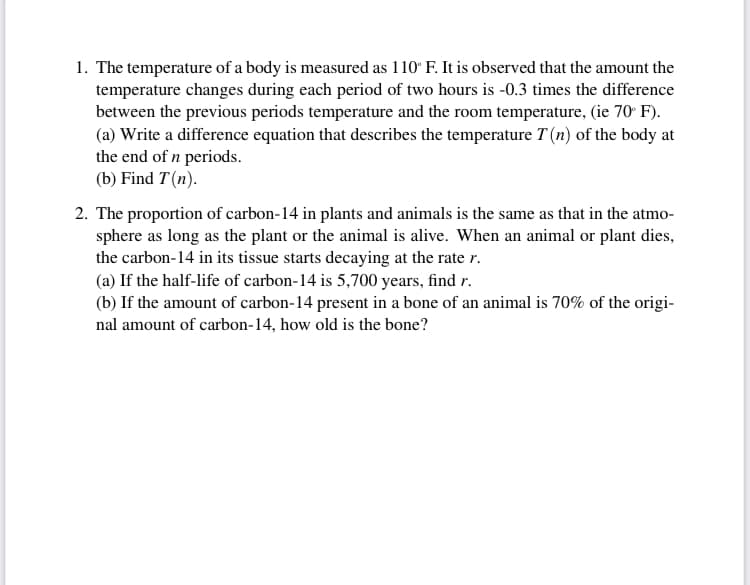1. The temperature of a body is measured as 110° F. It is observed that the amount the temperature changes during each period of two hours is -0.3 times the difference between the previous periods temperature and the room temperature, (ie 70° F). (a) Write a difference equation that describes the temperature T(n) of the body at the end of n periods. (b) Find T(n).
1. The temperature of a body is measured as 110° F. It is observed that the amount the temperature changes during each period of two hours is -0.3 times the difference between the previous periods temperature and the room temperature, (ie 70° F). (a) Write a difference equation that describes the temperature T(n) of the body at the end of n periods. (b) Find T(n).
Algebra: Structure And Method, Book 1
(REV)00th Edition
ISBN:9780395977224
Author:Richard G. Brown, Mary P. Dolciani, Robert H. Sorgenfrey, William L. Cole
Publisher:Richard G. Brown, Mary P. Dolciani, Robert H. Sorgenfrey, William L. Cole
Chapter9: Systems Of Linear Equations
Section9.6: Wind And Water Current Problems
Problem 14OE
Related questions
Question

Transcribed Image Text:1. The temperature of a body is measured as 110° F. It is observed that the amount the
temperature changes during each period of two hours is -0.3 times the difference
between the previous periods temperature and the room temperature, (ie 70 F).
(a) Write a difference equation that describes the temperature T (n) of the body at
the end of n periods.
(b) Find T(n).
2. The proportion of carbon-14 in plants and animals is the same as that in the atmo-
sphere as long as the plant or the animal is alive. When an animal or plant dies,
the carbon-14 in its tissue starts decaying at the rate r.
(a) If the half-life of carbon-14 is 5,700 years, find r.
(b) If the amount of carbon-14 present in a bone of an animal is 70% of the origi-
nal amount of carbon-14, how old is the bone?
Expert Solution
This question has been solved!
Explore an expertly crafted, step-by-step solution for a thorough understanding of key concepts.
Step by step
Solved in 2 steps

Recommended textbooks for you

Algebra: Structure And Method, Book 1
Algebra
ISBN:
9780395977224
Author:
Richard G. Brown, Mary P. Dolciani, Robert H. Sorgenfrey, William L. Cole
Publisher:
McDougal Littell

Linear Algebra: A Modern Introduction
Algebra
ISBN:
9781285463247
Author:
David Poole
Publisher:
Cengage Learning

Algebra & Trigonometry with Analytic Geometry
Algebra
ISBN:
9781133382119
Author:
Swokowski
Publisher:
Cengage

Algebra: Structure And Method, Book 1
Algebra
ISBN:
9780395977224
Author:
Richard G. Brown, Mary P. Dolciani, Robert H. Sorgenfrey, William L. Cole
Publisher:
McDougal Littell

Linear Algebra: A Modern Introduction
Algebra
ISBN:
9781285463247
Author:
David Poole
Publisher:
Cengage Learning

Algebra & Trigonometry with Analytic Geometry
Algebra
ISBN:
9781133382119
Author:
Swokowski
Publisher:
Cengage

College Algebra
Algebra
ISBN:
9781305115545
Author:
James Stewart, Lothar Redlin, Saleem Watson
Publisher:
Cengage Learning


Algebra for College Students
Algebra
ISBN:
9781285195780
Author:
Jerome E. Kaufmann, Karen L. Schwitters
Publisher:
Cengage Learning